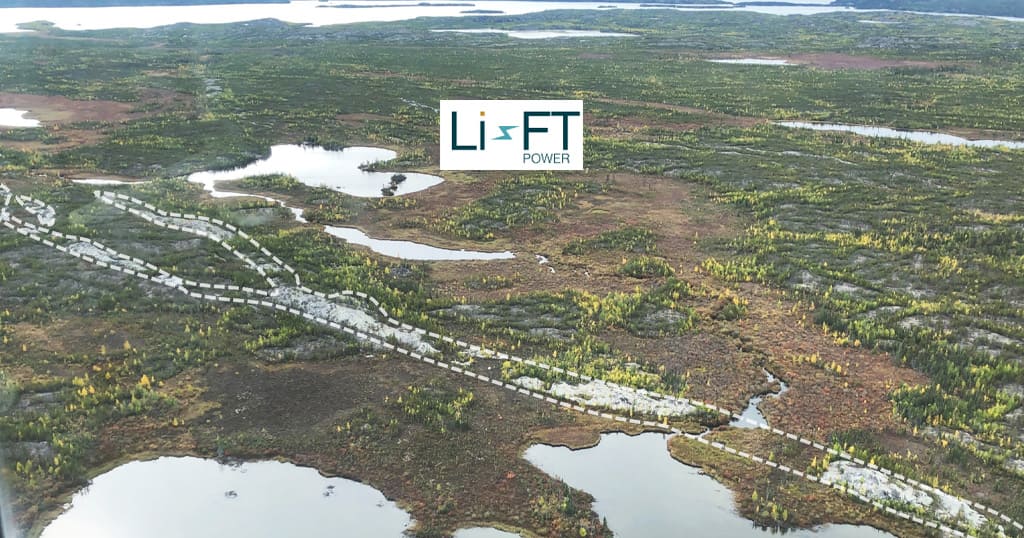Li-FT Power Ltd. report assays from 8 drill holes completed at the Fi Southwest, BIG West, Nite, & Echo pegmatites within the Yellowknife Lithium Project (“YLP”) located outside the city of Yellowknife, Northwest Territories (Figure 1). Drilling intersected significant intervals of spodumene mineralization, with the following highlights:
Highlights:
- YLP-0200: 19 m at 1.31% Li2O, (Fi Southwest)
- YLP-0203: 13 m at 1.24% Li2O, (Echo)
and: 1 m at 0.51% Li2O
- YLP-0205: 8 m at 1.39% Li2O, (Echo)
and: 7 m at 0.96% Li2O
and: 8 m at 0.73% Li2O
- YLP-0198: 3 m at 1.13% Li2O, (Nite)
and: 10 m at 0.72% Li2O
including: 3 m at 1.20% Li2O
- YLP-0188: 1 m at 1.02% Li2O, (BIG West)
Discussion of Results
This news release provides results for eight holes drilled for 1,116 m as part of the 2024 and 2023 exploration programs. These results include holes drilled on the Fi Southwest, Nite, Echo, and BIG West pegmatite complexes. A table of composite calculations, general comments related to this discussion, and a table of collar headers are provided towards the end of this section.
“The Fi Southwest continues to return robust intercepts of mineralization with hole 203 drilling 19 m at 1.31% Li2O. Drilling on the Fi Southwest has defined 900 m of shallow mineralization to date, so we are very excited to continue to step-out from these numbers to depth. Drilling at the northwest end of Echo also continued to return grade and width this week with hole 200 returning an impressive 13 m of 1.2% Li2O, 350 m from 13 m of 1.24% Li2O, 13 m of 1.48% Li2O and 11 m of 1.42% Li2O drilled in 2023.”
Dave Smithson, SVP, Geology of LIFT
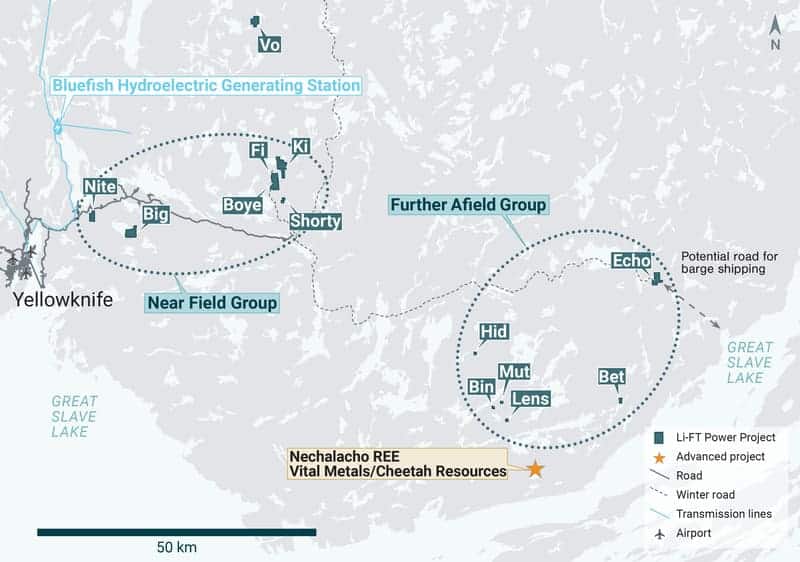
The Fi SW dyke strikes over at least 1.1 km on surface with an average outcropping width of approximately 20 m. The dyke dips between 60°-80° to the east-southeast and trends towards the north-northeast. Drilling of Fi SW show that it ranges from a single 20-40 m wide dyke to 2-3 dykes of similar cumulative width within a 50-70 m wide corridor.
YLP-0200 tested the Fi SW pegmatite approximately 250 m from its northern mapped extent and 50 m below the surface, and in between sections located 50 m north and 50 m south that, from 2023 drilling, returned intersections of 1.0-1.5% Li2O over 20-25 m to approximately 200 m depth. New drilling intersected a single 26 m pegmatite that returned 1.31% Li2O over 19 m (Table 1 & 2, Figures 2 & 3).
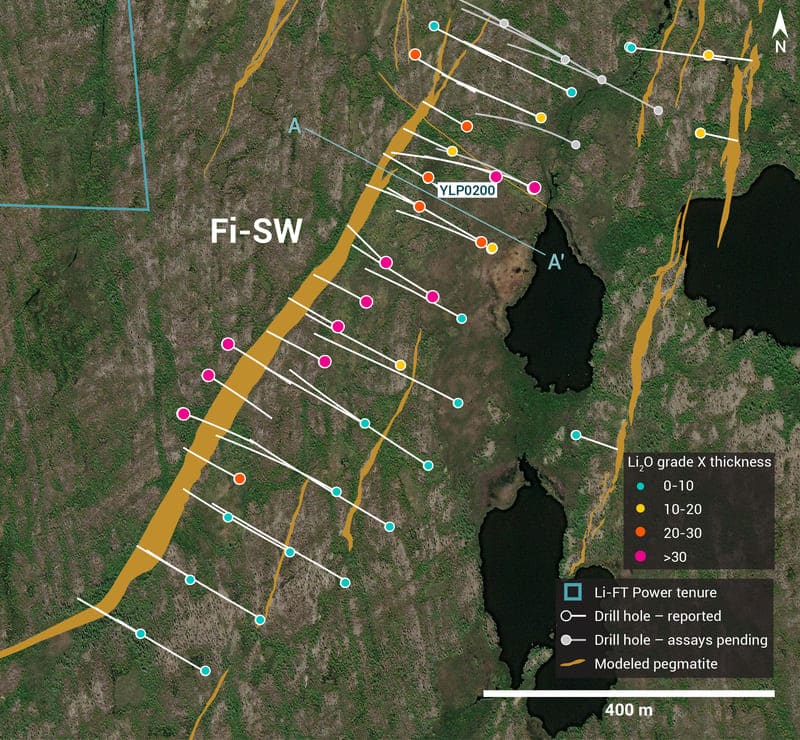
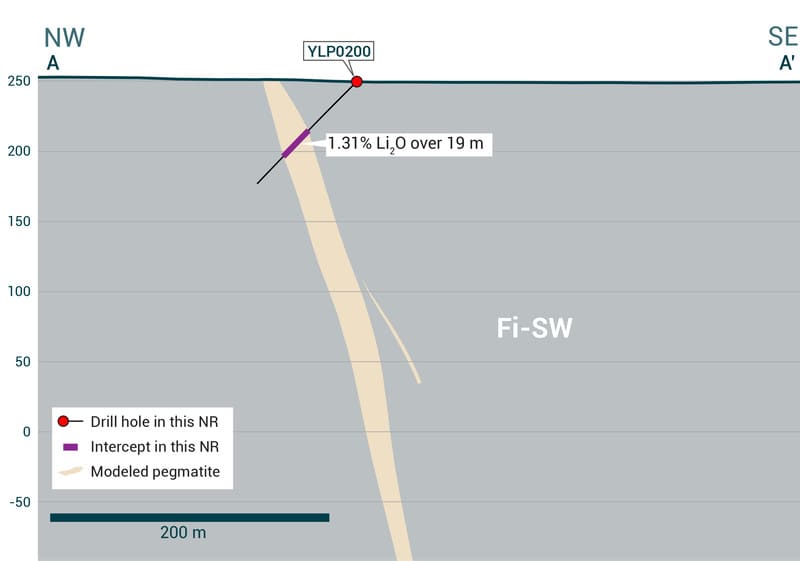
Echo Pegmatite
The Echo pegmatite complex comprises a steeply dipping, northwest-trending, feeder dyke that splits into a fanning splay of moderate- to gently dipping dykes at its northwest end. The dyke complex has a total strike length of over 1.0 km with individual dykes up to 25 m wide. The holes described below were collared on the fanning splay part of the complex that consists of several subparallel moderate to shallow dipping dykes.
YLP-0202 tested the northwestern fanning splay of the Echo complex, within 100 m of its mapped extent, <25 m below the surface, as well as 50 and 100 m along strike from YLP-0203 and 0205 respectively (see below) and 200 m along strike from previously released YLP-0128 (1.24% Li2O over 10 m and 0.69% Li2O over 12 m). Drilling intersected a 10 m dyke flanked by 1-3 m wide dykes for cumulative 14 m pegmatite over 25 m of core. Assays returned composites of 0.90% Li2O over 3 m and 0.50% Li2O over 7 m, the latter including a 2 m interval that returned 1.32% Li2O.
YLP-0203 was collared 50 m east of YLP-0202 to test the same dyke system at 25-50 m below the surface. Drilling intersected a 15 m dyke and a 10 m dyke separated by 16 m of country rock, with the upper and thickest dyke returning an assay composite of 1.24% Li2O over 13 m. The lower dyke returned a wall-to-wall composite of 0.21% Li2O over 10 m that includes one metre of 0.51% Li2O.
YLP-0205 was collared halfway between YLP-0202 and YLP-0128 to test the Echo dyke fan at 50 m beneath the surface. Drilling intersected two clusters of dykes that are separated by ~20 m of country rock; the upper group consists of four dykes between 2-8 m in width for cumulative 25 m of pegmatite in 56 m of core whereas the lower group consists of two dykes that are each 2 metres wide and separated by 6 m of country rock. Assays from the upper group of dykes returned composites of 1.39% Li2O over 8 m, 0.96% Li2O over 7 m, and 0.73% Li2O over 8 m for a combined 23 m of pegmatite at 1.03% Li2O. The lower group returned negligible grades (Table 1 & 2, Figures 4 & 5).
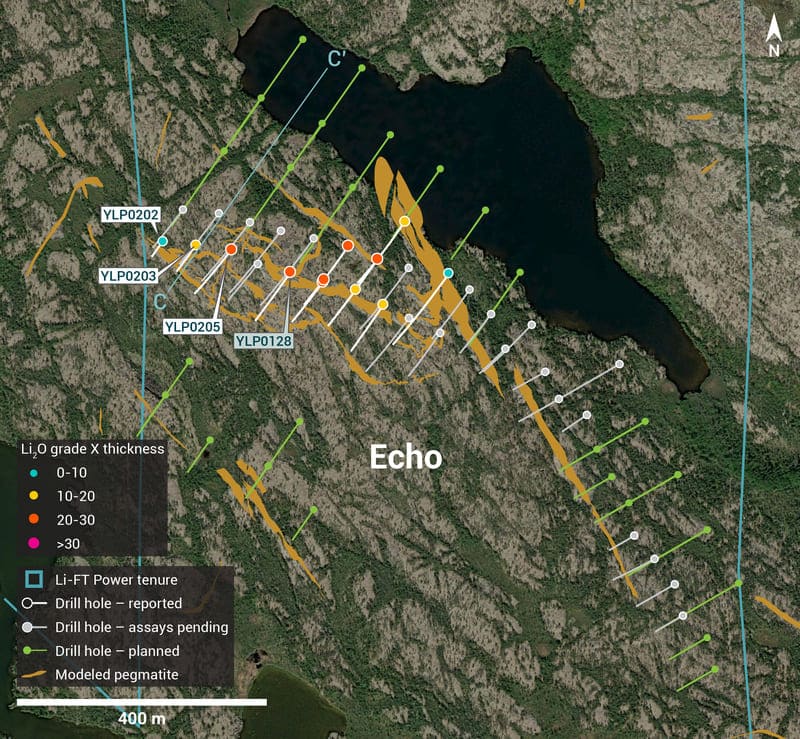
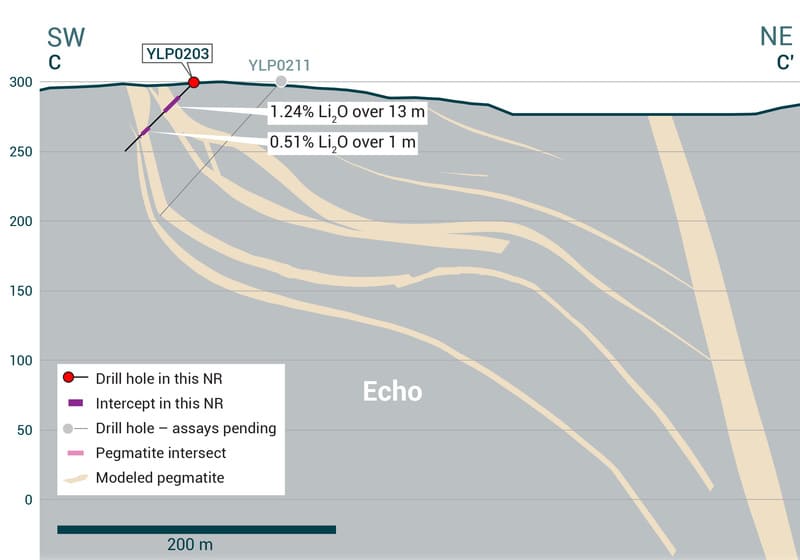
Nite Pegmatite
The Nite pegmatite complex comprises a north-northeast trending corridor of parallel-trending dykes that is exposed for at least 1.4 km of strike length and dips approximately 50°-70° to the east. The northern part of this complex consists of a main dyke flanked by one or more thinner dykes whereas the southern part comprises a fanning splay of 5-10 thinner dykes that is up to 200 m wide.
YLP-0193 explored the Nite pegmatite approximately 700 m from its northern end and 150 m beneath the surface, as well as 100 m downdip of previously released YLP-0138 (1.51% Li2O over 12 m) and 100 m up-dip of YLP-0195 (1.00% Li2O over 15 m). Drilling intersected two groups of dykes separated by 30 m of country rock; an upper group of two dykes summing to 6 m of pegmatite over 9 m of core and a lower group of five dykes totaling 24 m of pegmatite over 44 m. Notable assays were returned for 3 of 5 dykes in the lower group, including 1.01% Li2O over 8 m, 0.72% Li2O over 1 m, and 0.56% Li2O over 1 m.
YLP-0196 was drilled on a section 100 m north of YLP-0193 to test the Nite pegmatite 50 m beneath the surface and 100 m up-dip of YLP-0198 (described below). Drilling intersected three dykes between 5-10 m in width for cumulative 21 m of pegmatite over 40 m of drill core. The upper-most and widest of these dykes returned 0.51% Li2O over 10 m that includes two higher-grade intervals of 1.0-1.1% Li2O over 2 m. The two lower dykes returned 0.70% Li2O over 6 m (including 1.12% Li2O over 3 m) and 0.59% Li2O over 1 m.
YLP-0198 was drilled 100 m downdip of YLP-0196 (see above) and intersected three 2-10 m wide dykes spaced 8-11 m apart for cumulative 22 m of pegmatite over 38 m of core. The two lower dykes each returned composites of 0.4-0.7% Li2O over 10 m that also each includes a 3 m interval of 1.1-1.2% Li2O (Table 1 & 2, Figures 6 & 7).
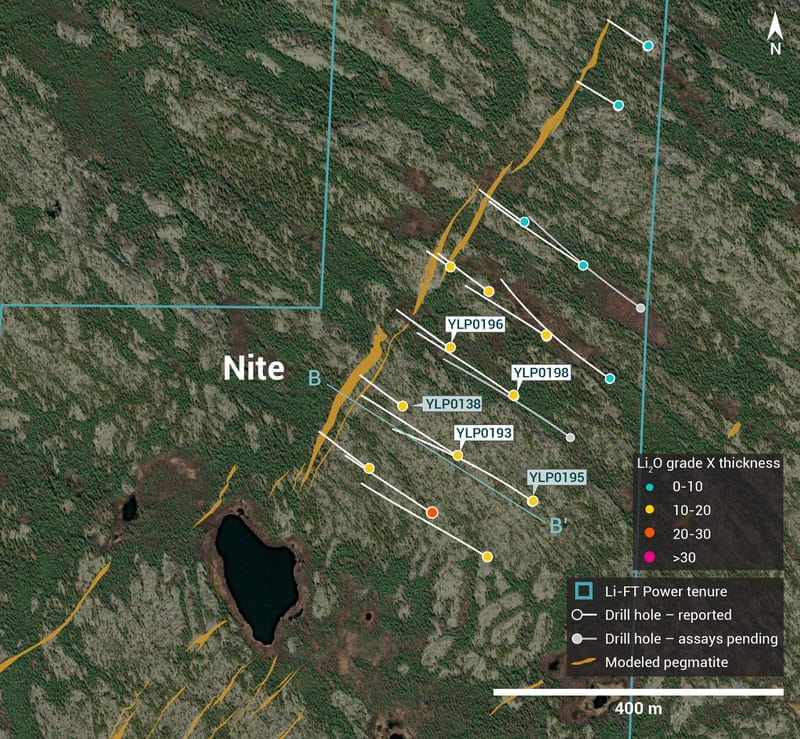
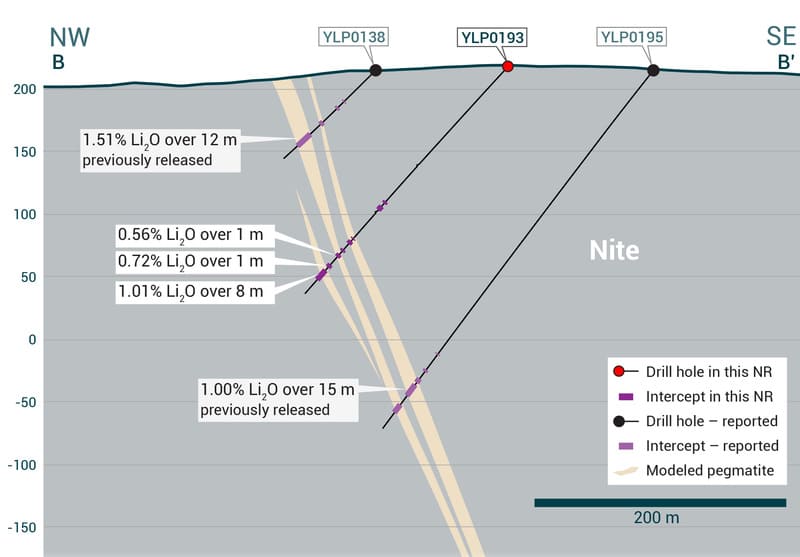
BIG West Pegmatite
The BIG West pegmatite complex comprises a northeast-trending corridor of parallel-trending dykes that is exposed for at least 1.5 km along strike and is steeply west dipping to subvertical. The complex is bound by two relatively continuous dyke structures that are 50-100 m apart in the northern half of the corridor and 150 m apart in the south. These dykes are here referred to as the east- (EB) and west-bounding (WB) dykes. Three of the holes reported here are the most northerly drilled on this complex.
YLP-0188 was collared on the transition between more widely and closely spaced EB and WB dykes, approximately 600 m from the southern mapped extent of the BIG West complex. Drilling was designed to test the BIG West corridor at 50-100 m beneath the surface and intersected three groups of 1-9 m wide pegmatite spaced 29-36 m apart. Assay results are generally negligible except a sample from one of the middle group dykes that returned 1.02% Li2O over 1 m (Table 1 & 2, Figure 8).
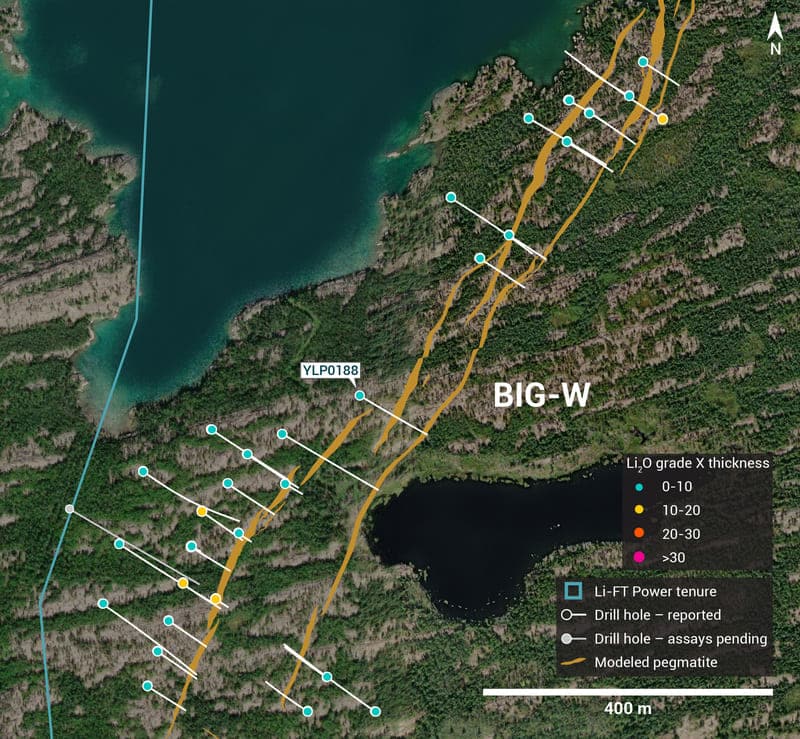
Table 1 – Assay highlights for drill holes reported in this press release.
| Hole No. | From (m) | To (m) | Interval (m) | Li2O% | Dyke |
| YLP-0188 | 56 | 57 | 1 | 1.02 | BIG West |
| YLP-0193 | 196 | 197 | 1 | 0.56 | Nite |
| and | 207 | 208 | 1 | 0.72 | |
| and | 213 | 221 | 8 | 1.01 | |
| YLP-0196 | 72 | 82 | 10 | 0.51 | Nite |
| inc | 73 | 75 | 2 | 1.05 | |
| inc | 79 | 81 | 2 | 1.02 | |
| and | 94 | 95 | 1 | 0.59 | |
| and | 106 | 112 | 6 | 0.70 | |
| inc | 107 | 110 | 3 | 1.12 | |
| YLP-0198 | 190 | 193 | 3 | 1.13 | Nite |
| and | 207 | 217 | 10 | 0.72 | |
| inc | 211 | 214 | 3 | 1.20 | |
| YLP-0200 | 50 | 69 | 19 | 1.31 | Fi SW |
| YLP-0202 | 3 | 6 | 3 | 0.90 | Echo |
| and | 11 | 18 | 7 | 0.50 | |
| inc | 14 | 16 | 2 | 1.32 | |
| YLP-0203 | 16 | 29 | 13 | 1.24 | Echo |
| and | 51 | 52 | 1 | 0.51 | |
| YLP-0205 | 24 | 32 | 8 | 1.39 | Echo |
| and | 44 | 51 | 7 | 0.96 | |
| and | 72 | 80 | 8 | 0.73 |
General Statements
All eight described in this news release were drilled broadly perpendicular to the dyke orientation so that the true thickness of reported intercepts will range somewhere between 65-100% of the drilled widths. A collar header table is provided below.
Mineralogical characterization for the YLP- pegmatites is in progress through hyperspectral core scanning and X-ray diffraction work. Visual core logging indicates that the predominant host mineral is spodumene.
Table 2 – Drill collars table of reported drill holes in this press release
| Drill Hole | NAD83 | Easting | Northing | Elevation (m) | Azimuth (°) | Dip (°) | Depth (m) | Dyke | |
| YLP-0188 | Zone 11 | 653,870 | 6,933,284 | 212 | 115 | 45 | 158 | BIG West | |
| YLP-0193 | Zone 11 | 647,569 | 6,936,261 | 213 | 298 | 48 | 237 | Nite | |
| YLP-0196 | Zone 11 | 647,545 | 6,936,408 | 204 | 298 | 45 | 128 | Nite | |
| YLP-0198 | Zone 11 | 647,638 | 6,936,351 | 206 | 298 | 50 | 251 | Nite | |
| YLP-0200 | Zone 12 | 371,409 | 6,940,953 | 250 | 302 | 45 | 102 | Fi SW | |
| YLP-0202 | Zone 12 | 438,904 | 6,922,693 | 295 | 215 | 45 | 42 | Echo | |
| YLP-0203 | Zone 12 | 438,957 | 6,922,687 | 299 | 215 | 45 | 72 | Echo | |
| YLP-0205 | Zone 12 | 439,014 | 6,922,680 | 304 | 215 | 45 | 126 | Echo | |
QA/QC & Core Sampling Protocols
All drill core samples were collected under the supervision of LIFT employees and contractors. Drill core was transported from the drill platform to the core processing facility where it was logged, photographed, and split by diamond saw prior to being sampled. Samples were then bagged, and blanks and certified reference materials were inserted at regular intervals. Field duplicates consisting of quarter-cut core samples were also included in the sample runs. Groups of samples were placed in large bags, sealed with numbered tags in order to maintain a chain-of-custody, and transported from LIFT’s core logging facility to ALS Labs (“ALS”) laboratory in Yellowknife, Northwest Territories.
Sample preparation and analytical work for this drill program were carried out by ALS. Samples were prepared for analysis according to ALS method CRU31: individual samples were crushed to 70% passing through 2 mm (10 mesh) screen; a 1,000-gram sub-sample was riffle split (SPL-21) and then pulverized (PUL-32) such that 85% passed through 75-micron (200 mesh) screen. A 0.2-gram sub-sample of the pulverized material was then dissolved in a sodium peroxide solution and analysed for lithium according to ALS method ME-ICP82b. Another 0.2-gram sub-sample of the pulverized material was analysed for 53 elements according to ALS method ME-MS89L. All results passed the QA/QC screening at the lab, all inserted standards and blanks returned results that were within acceptable limits.
Qualified Person
The disclosure in this news release of scientific and technical information regarding LIFT’s mineral properties has been reviewed and approved by Ron Voordouw, Ph.D., P.Geo., Partner, Director Geoscience, Equity Exploration Consultants Ltd., and a Qualified Person as defined by National Instrument 43-101 Standards of Disclosure for Mineral Projects (NI 43-101) and member in good standing with the Northwest Territories and Nunavut Association of Professional Engineers and Geoscientists (NAPEG) (Geologist Registration number: L5245).
About LIFT
LIFT is a mineral exploration company engaged in the acquisition, exploration, and development of lithium pegmatite projects located in Canada. The Company’s flagship project is the Yellowknife Lithium Project located in Northwest Territories, Canada. LIFT also holds three early-stage exploration properties in Quebec, Canada with excellent potential for the discovery of buried lithium pegmatites, as well as the Cali Project in Northwest Territories within the Little Nahanni Pegmatite Group.
For further information, please contact:
Francis MacDonald
Chief Executive Officer
Tel: + 1.604.609.6185
Email: [email protected]
Website: www.li-ft.com
Daniel Gordon
Investor Relations
Tel: +1.604.609.6185
Email: [email protected]
Cautionary Statement Regarding Forward-Looking Information
Certain statements included in this press release constitute forward-looking information or statements (collectively, “forward-looking statements”), including those identified by the expressions “anticipate”, “believe”, “plan”, “estimate”, “expect”, “intend”, “may”, “should” and similar expressions to the extent they relate to the Company or its management. The forward-looking statements are not historical facts but reflect current expectations regarding future results or events. This press release contains forward looking statements. These forward-looking statements and information reflect management’s current beliefs and are based on assumptions made by and information currently available to the company with respect to the matter described in this new release.
Forward-looking statements involve risks and uncertainties, which are based on current expectations as of the date of this release and subject to known and unknown risks and uncertainties that could cause actual results to differ materially from those expressed or implied by such statements. Additional information about these assumptions and risks and uncertainties is contained under “Risk Factors and Uncertainties” in the Company’s latest annual information form filed on March 30, 2023, which is available under the Company’s SEDAR+ profile at www.sedarplus.ca, and in other filings that the Company has made and may make with applicable securities authorities in the future. Forward-looking statements contained herein are made only as to the date of this press release and we undertake no obligation to update or revise any forward-looking statements whether as a result of new information, future events or otherwise, except as required by law. We caution investors not to place considerable reliance on the forward-looking statements contained in this press release.
Neither the TSX Venture Exchange nor its Regulation Services Provider (as that term is defined in the policies of the TSX Venture Exchange) accepts responsibility for the adequacy or accuracy of this news release.










